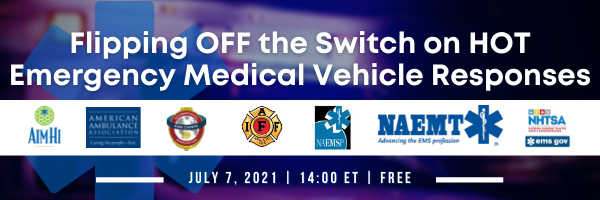Tag: National Highway Traffic Safety Administration (NHTSA)
EMS360: Fatigue Risk Management in EMS Webtool Demo
Fatigue Risk Management in EMS: Project Summary and Webtool Demo
NHTSA Publishes New National EMS Education Standards
Revised Standards outline minimum competencies for entry-level EMS clinicians to perform their roles
After a community-wide, collaborative effort, the newly updated National EMS Education Standards are now available. The Standards outline the critical topics to be covered in the initial education of EMS clinicians, based on the latest version of the National EMS Scope of Practice Model as well as recent research and best practices. The document defines the competencies, clinical behaviors, and judgments required of EMS personnel to perform their roles. They provide a high-level outline of those topics, and do not replace the need to develop a curriculum, nor are they intended to limit EMS educational programs from going beyond the Standards to meet student or community needs.
The National EMS Education Standards were first published in 2009, and this marks the first major revision. The National Highway Traffic Safety Administration (NHTSA) and the Health Resources and Services Administration, Maternal and Child Health Bureau’s EMS for Children Program funded the effort through a process led by the National Association of EMS Educators.
“EMS clinicians are the most critical resource in our nation’s EMS systems, and education is the foundation upon which those clinicians are created,” said Dr. Jon Krohmer, director of the NHTSA Office of EMS. “These newly released National EMS Education Standards, created by the EMS community, will help educators and education content providers continue to create competent, compassionate clinicians dedicated to providing people-centered, evidence-based care to their communities.”
Visit EMS.gov to learn more about the revised 2021 National EMS Education Standards, download the Standards themselves, and find frequently asked questions about the project.
NHTSA Office of EMS Annual Update
The NHTSA Office of EMS continues to work with our partners to advance EMS systems and support EMS clinicians serving on the front lines. Together, we are striving to achieve the vision of a people-centered EMS system put forth in EMS Agenda 2050.
Thank you to all who have helped make great strides in 2021, even in the face of some of the greatest challenges we’ve ever faced as a profession—and a country. This year’s NHTSA Office of EMS Annual Update highlights some of the work happening at the national level, including:
- Newly revised National EMS Education Standards
- Evidence-based guidelines to support safe and effective patient care
- Advances in EMS data collection and analysis
- The COVID-19 response
Click here to read our summary of 2021 accomplishments and review the status of ongoing projects. Most important, look for ways that you can get involved in national efforts to improve EMS and create a better future for our profession, our patients and our communities.
EMS.gov | NEMSAC Members Appointed
From EMS.gov on October 6
|
|
|
EMS.gov | Template Protocol for EMS Administration of Monoclonal Antibodies
From EMS.gov on August 27, 2021
To assist EMS agencies in planning, the NHTSA Office of EMS and HHS Office of the Assistant Secretary for Preparedness and Response have developed a template protocol for state EMS offices and EMS Medical Directors to use to assist in these programs. Some states have created blanket state-level authorizations for EMS administration; some states will still require provider authorization prior to administration. Please follow local protocols and regulations. This template is only designed to facilitate the development of those local protocols as needed. Please contact the NHTSA Office of EMS with any questions.
EMS.gov | Information About COVID-19 for EMS Systems and Clinicians
From EMS.gov
|
|
NHTSA | Office of EMS Director Jon Krohmer, MD, to Retire
NHTSA Office of EMS Director Jon Krohmer, MD, to Retire Later this Year
After 15 years of federal service, including the last five leading the National Highway Traffic Safety Administration Office of EMS, Jon Krohmer, MD, will be retiring in November.
During his tenure as director, Dr. Krohmer and the NHTSA Office of EMS team oversaw a number of milestones for the profession, including the creation of EMS Agenda 2050; major revisions to the National EMS Scope of Practice Model and the National EMS Education Standards; and improvements in the collection and use of EMS data through the expansion of the National EMS Information System. Soon after the onset of the coronavirus pandemic, Dr. Krohmer was tapped to lead the prehospital/911 team as part of the Federal Healthcare Resilience Task Force.
“Dr. Krohmer’s tenure at NHTSA—especially over the last year and a half as EMS clinicians have faced one of the greatest public health challenges in generations—has been marked by real advances for the profession, thanks in no small part to his leadership,” said Nanda Srinivasan, NHTSA’s associate administrator for research and program development. “He was a true advocate at the federal level for state, tribal and local EMS systems, EMS clinicians, and patients.”
Prior to joining NHTSA, Dr. Krohmer had decades of experience as a local EMS medical director, initially in his home state of Michigan. His EMS career began as an EMT with a volunteer rescue squad. Like many EMS professionals, he was inspired by the television show Emergency! and by the emergence of the relatively new field of emergency medicine. He entered medical school at the University of Michigan knowing he wanted to make EMS his career. After becoming involved in EMS at the state and national level, he also served as president of the National Association of EMS Physicians from 1998 to 2000. In 2006, he came to Washington to serve as the first deputy chief medical officer for the Department of Homeland Security Office of Health Affairs and served in several other DHS roles before joining NHTSA in 2016.
“Working alongside EMS clinicians and the people who support them at local, state and national levels has been a privilege and a heck of a lot of fun,” said Dr. Krohmer. “The decision to leave NHTSA was difficult, but it’s made easier knowing that the team in the Office of EMS, our colleagues throughout the federal government, and leaders of EMS at state and local levels are committed to improving the lives of people in their communities and will continue to advance EMS systems everywhere.”
NHTSA will launch a national search for a new director for the Office of EMS.
“The example set by Dr. Krohmer will serve as a great model for the next director,” said Associate Administrator Srinivasan, “and the team of dedicated public servants at the Office of EMS has the experience and expertise to ensure a smooth transition.”
On-Demand | Flipping OFF the Switch on HOT Emergency Medical Vehicle Responses!
.png) Flipping OFF the Switch on HOT Emergency Medical Vehicle Responses!
Flipping OFF the Switch on HOT Emergency Medical Vehicle Responses!
Recorded July 7, 2021 | 14:00–15:15 pm ET | FREE Webinar
Download Slide Deck | Watch on YouTube
HOT (red light and siren) responses put EMS providers and the public at significant risk. Studies have demonstrated that the time saved during this mode of vehicle operation and that reducing HOT responses enhances safety of personnel, with little to no impact on patient outcomes. Some agencies have ‘dabbled’ with responding COLD (without lights and sirens) to some calls, but perhaps none as dramatic as Niagara Region EMS in Ontario, Canada – who successfully flipped their HOT responses to a mere 10% of their 911 calls! Why did they do it? How did they do it? What has been the community response? What has been the response from their workforce? Has there been any difference in patient outcomes? Join Niagara Region EMS to learn the answers to these questions and more. Panelists from co-hosting associations will participate to share their perspectives on this important EMS safety issue!
Speakers
Kevin Smith, BAppB:ES, CMM III, ACP, CEMC
Chief
Niagara Emergency Medical Services
Jon R. Krohmer, MD, FACEP, FAEMS
Director, Office of EMS
National Highway Traffic Safety Administration
Team Lead, COVID-19 EMS/Prehospital Team
Douglas F. Kupas, MD, EMT-P, FAEMS, FACEP
Medical Director, NAEMT
Medical Director, Geisinger EMS
Matt Zavadsky, MS-HSA, NREMT
Chief Strategic Integration Officer
MedStar Mobile Integrated Healthcare
Bryan R. Wilson, MD, NRP, FAAEM
Assistant Professor of Emergency Medicine
St. Luke’s University Health Network
Medical Director, City of Bethlehem EMS
Robert McClintock
Director of Fire & EMS Operations
Technical Assistance and Information Resources
International Association of Fire Fighters
Mike McEvoy, PhD, NRP, RN, CCRN
Chair – EMS Section Board – International Association of Fire Chiefs
EMS Coordinator – Saratoga County, New York
Chief Medical Officer – West Crescent Fire Department
Professional Development Coordinator – Clifton Park & Halfmoon EMS
Cardiovascular ICU Nurse Clinician – Albany Medical Center
6/16 | Federal Interagency Committee on EMS Virtual Meeting
|
|
|
|
Webinar 7/7 | Lights & Sirens Responses

Flipping OFF the Switch on HOT Emergency Medical Vehicle Responses!
Free Webinar July 7 | 14:00–15:15 ET
HOT (red light and siren) responses put EMS providers and the public at significant risk. Studies have demonstrated that the time saved during this mode of vehicle operation and that reducing HOT responses enhances safety of personnel, with little to no impact on patient outcomes. Some agencies have ‘dabbled’ with responding COLD (without lights and sirens) to some calls, but perhaps none as dramatic as Niagara Region EMS in Ontario, Canada – who successfully flipped their HOT responses to a mere 10% of their 911 calls! Why did they do it? How did they do it? What has been the community response? What has been the response from their workforce? Has there been any difference in patient outcomes? Join Niagara Region EMS to learn the answers to these questions and more. Panelists from co-hosting associations will participate to share their perspectives on this important EMS safety issue!
Speakers
Kevin Smith, BAppB:ES, CMM III, ACP, CEMC
Chief
Niagara Emergency Medical Services
Jon R. Krohmer, MD, FACEP, FAEMS
Team Lead, COVID-19 EMS/Prehospital Team
Director, Office of EMS
National Highway Traffic Safety Administration
Douglas F. Kupas, MD, EMT-P, FAEMS, FACEP
Medical Director, NAEMT
Medical Director, Geisinger EMS
Matt Zavadsky, MS-HSA, NREMT
Chief Strategic Integration Officer
MedStar Mobile Integrated Healthcare
Bryan R. Wilson, MD, NRP, FAAEM
Assistant Professor of Emergency Medicine
St. Luke’s University Health Network
Medical Director, City of Bethlehem EMS
Robert McClintock
Director of Fire & EMS Operations
Technical Assistance and Information Resources
International Association of Fire Fighters
Mike McEvoy, PhD, NRP, RN, CCRN
Chair – EMS Section Board – International Association of Fire Chiefs
EMS Coordinator – Saratoga County, New York
Chief Medical Officer – West Crescent Fire Department
Professional Development Coordinator – Clifton Park & Halfmoon EMS
Cardiovascular ICU Nurse Clinician – Albany Medical Center
NEMSIS 2020 Public-Dataset Now Available
From NEMSIS on May 28, 2021
FOR IMMEDIATE RELEASE
NEMSIS 2020 Public-Dataset Now Available
Salt Lake City, Utah, May 11, 2021 – The National Emergency Medical Services Information System Technical
Assistance Center (NEMSIS TAC) today announced the availability of the 2020 Public-Release Research Dataset,
the largest publicly available dataset of emergency medical service activations in the United States. With this
release, NEMSIS aims to improve understanding of, confidence in, and support for EMS data collection and
analysis that will lead to data being utilized more effectively to improve patient care.
“The 2020 dataset is a powerful asset for researchers looking into all manner of conditions that affect different
aspects of EMS service.,” said Dr. N. Clay Mann, Professor in the Department of Pediatrics at the University of
Utah School of Medicine and Principal Investigator for the NEMSIS Technical Assistance Center. “Hopefully, the
information gathered during the COVID-19 pandemic will help give EMS agencies valuable insight on their work
improving EMS services under all sorts of conditions.”
The 2020 Public-Release Research Dataset is a subset of the National EMS Database that is the repository for
EMS data collected from U.S. States and Territories. NEMSIS maintains the national standard for how patient
care information resulting from an emergency 9-1-1 call for medical assistance is collected. The dataset includes
43,488,767 EMS activations submitted by 12,319 EMS agencies servicing 50 states and territories.
Those interested in requesting a copy of the 2020 Public-Release Research Dataset can contact the NEMSIS TAC
and fill out a request form at their website https://nemsis.org/using-ems-data/request-research-data. A
password-protected USB drive containing the dataset, the 2020 NEMSIS Data User Manual, NEMSIS Data
Dictionary v3.4.0, Extended Data Definitions v3.4.0, and sample SAS code file will be sent via postal service.
ABOUT NEMSIS
The National Emergency Medical Services Information System (NEMSIS) is the national health information
exchange and database used to collect and store EMS data from states and territories. NEMSIS is a universal
standard for how patient care information resulting from an emergency 9-1-1 call for medical assistance is
collected. It is a collaborative system to improve patient care through the standardization, aggregation, and
utilization of point-of-care EMS data at a local, state, and national level.
NEMSIS is a program of NHTSA’s Office of EMS and is hosted at the University of Utah.
NHTSA EMS.gov | EMS Week Video
From NHTSA’s Office of EMS on May 17, 2021
This week, May 16-22, 2021, we once again recognize the people of EMS by celebrating National EMS Week. We hope you’ll take a minute to watch this special message from the entire team here at the National Highway Traffic Safety Administration Office of EMS.
This year’s EMS Week theme, “This is EMS: Caring for our Communities,” couldn’t be more appropriate. The past year has been a challenge, but it has also reminded people across the nation just how valuable emergency medical services systems—and most important, clinicians—are to our communities. This nation is in debt to all of the EMS clinicians and the people behind the scenes who show up every day with true professionalism and dedication.
From all of us here at the Office of EMS, NHTSA, and the Department of Transportation: Thank you.
- 1
- 2









